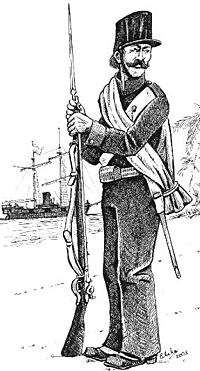
Originally the KNIL was part of the Dutch army. On March 10, 1830 the formation of the East Indies Army was approved by Royal Decree, consisting of 8 Mobile Corps, each with a battalion of Infantry, a company of Cavalry and four pieces mountain artillery, with a total strength of 600 European and 37 native officers and 12,905 non-commissioned officers and lower ranks. This grew to 20,000 in 1840, 29,800 in 1882 and 36,900 in 1930. Some of the action it was involved in: Padri War, (West-Sumatra) 1821-1845; Java War, July 1825-1830, Bali 1849; War of Aceh (Atjeh-oorlog) 1873-1901. [Ref: 1]
One point of interest was the recruitment of 3,000 West Africans, mainly from present-day Ghana, to serve in the Netherlands East Indies army. The vast majority of recruits were ex-slaves who purchased their freedom with an advance on their army pay. In the East Indies, they counted as part of the European formation of the army and were entitled to equal treatment with European soldiers [Ref: 2]. Balinese accounts refer to "African people" in the ranks of the KNIL force that attacked Jagaraga.
The uniform of the KNIL troops of the 1840s [see illustration] appears to be one heavily influenced by the French style of the era. Images from the era depict the troops in dark colored short jackets and dark colored loose trousers with spats over their boots. Presumably the dark color is blue but none of the references I have show uniforms in color. Cross-belts appear to be white and some soldiers are seen wearing blanket rolls. Shakos are black with no ornaments, perhaps protected with a waterproof cover. Officers wear a similar uniform but with a fuller coat, no cross-belts and fringed shoulder epaulettes. KNIL firearms appear to be the normal type of musket of the era. I have no information if it was rifled but from the appearance of small pouches, possibly cap pouches, on waist-belts of soldiers it does seem that the percussion cap system was standard.
Artillery that took part in the second attack on Jagaraga are reported to be "heavy" guns and howitzers but no details of caliber of weight is given. An assumption could be made that as the guns were too heavy to transport across road-less country they were probably at least of medium caliber. One can only assume that the KNIL uniforms were modified in the field as a concession to the tropical climate but artists impressions of the troops in action do not indicate how, or even if, this was done.
The closest miniatures to approximate the appearance of the KNIL troops would appear to be French Crimean War era figures provided that the infantry have the short tailed jacket. French officers could also be used. At a pinch 1845 era shako wearing Mexicans could be used, once again provided that they have the short tailed jacket. I have no information regarding the appearance of the various groups of indigenous auxiliaries.
Bibliography
Ide Anak Agung Gde Agung, Bali in the 19th Century, Yayasan Obor Indonesia, 1991.
References:
1: http://www.vanderheijden.org/ng/military.html
2: http://asc.leidenuniv.nl/research/project114.htm
Dutch Colonial Campaigns in Bali 1846-1849
- The First Buleleng War 1846
The Second Buleleng War 1848 - 1849
First Battle at Jagaraga 9th June 1848
Second Battle at Jagaraga 15th-16th April 1849
The Fight for the "Bat Cave": Kumbasa and Beyond
Balinese Warriors and Weapons
Koninklijk Nederlandsch-Indisch Leger, KNIL (Royal Dutch East Indies Army)
Back to The Heliograph # 136 Table of Contents
Back to The Heliograph List of Issues
Back to Master Magazine List
© Copyright 2003 by Richard Brooks.
This article appears in MagWeb.com (Magazine Web) on the Internet World Wide Web.
Other articles from military history and related magazines are available at http://www.magweb.com